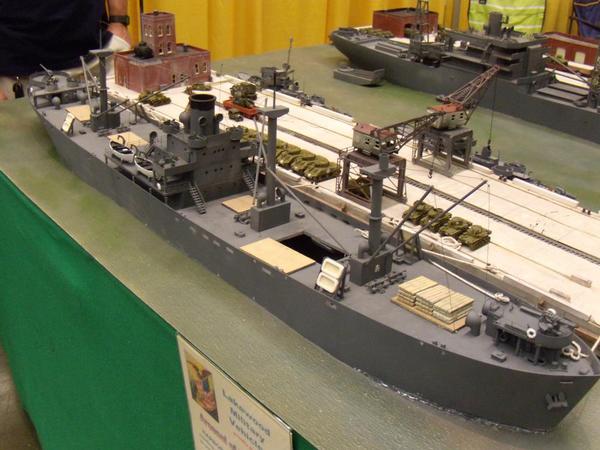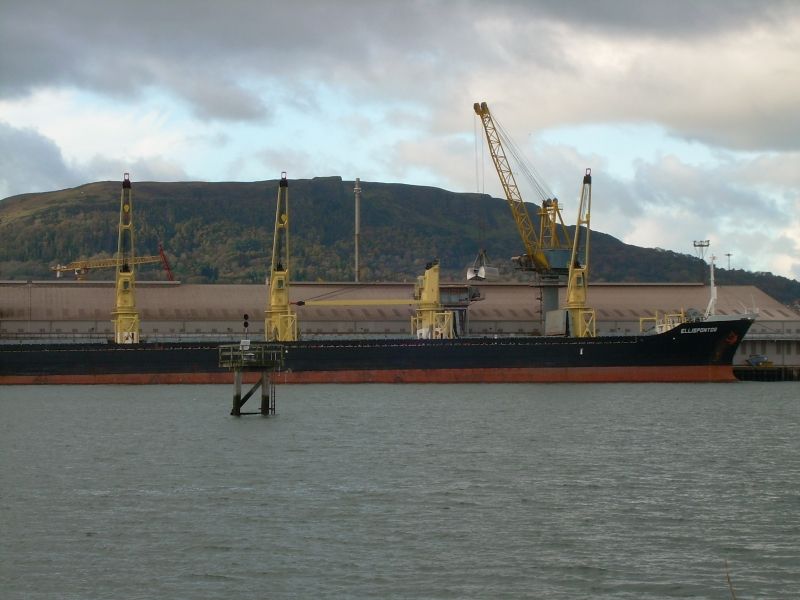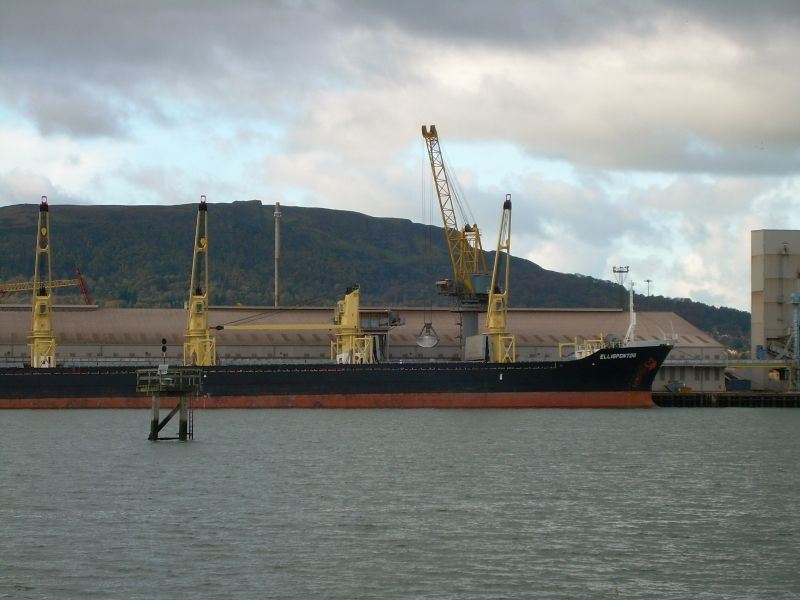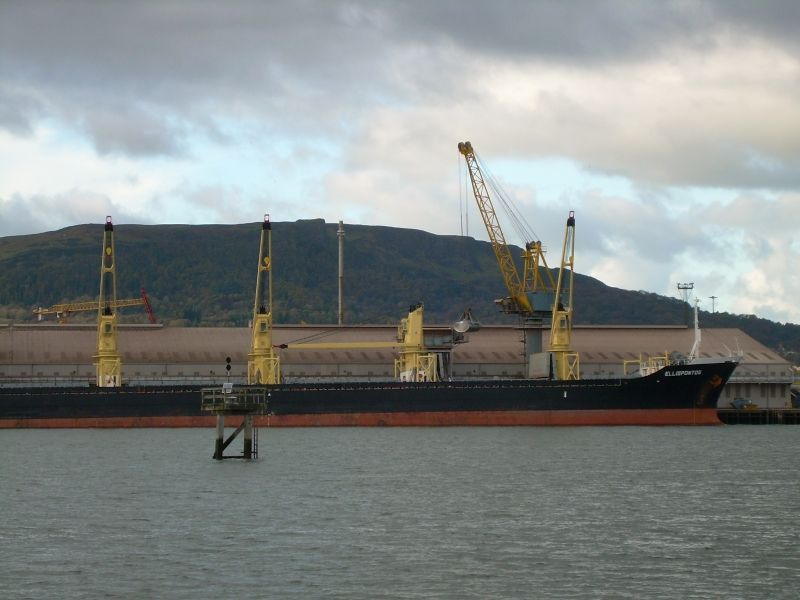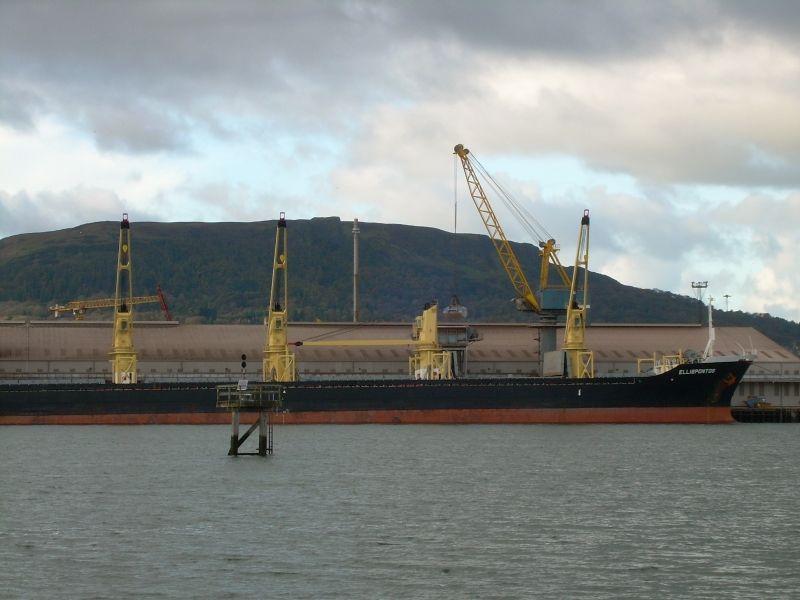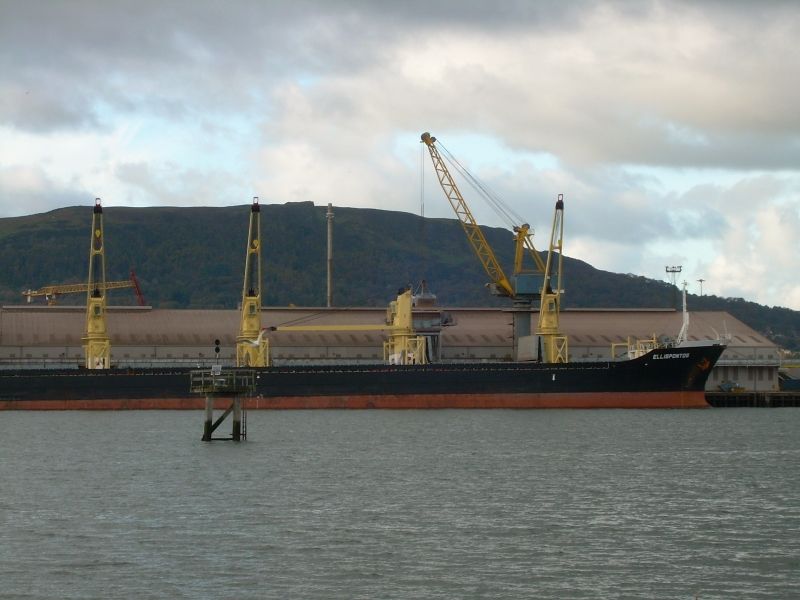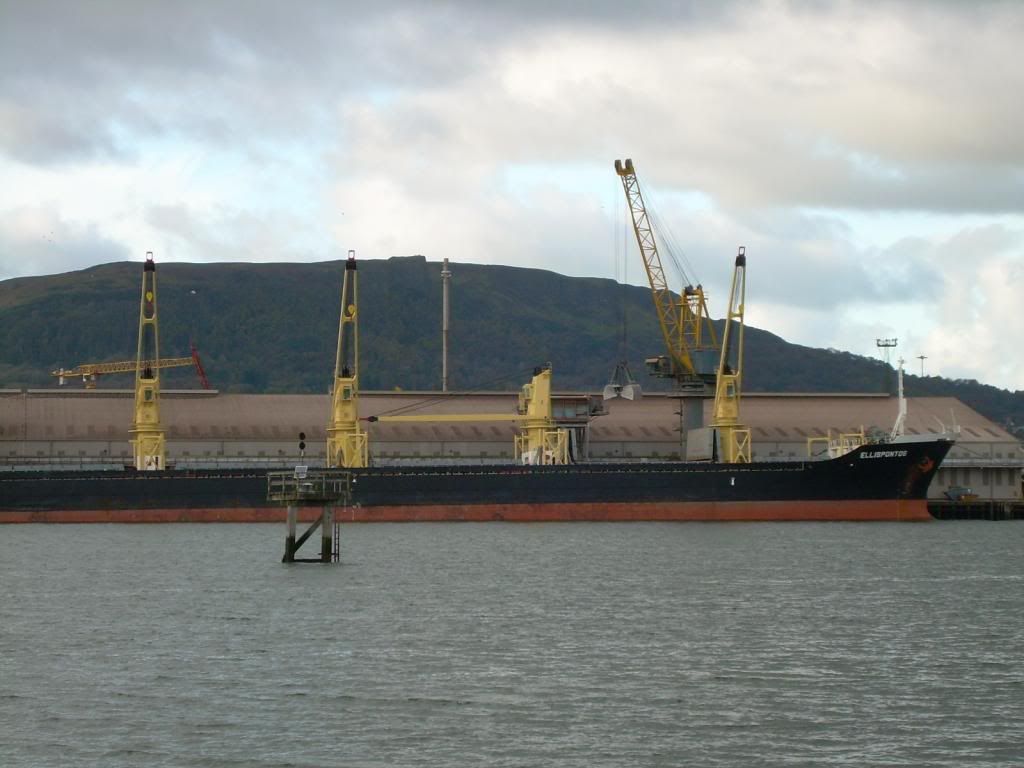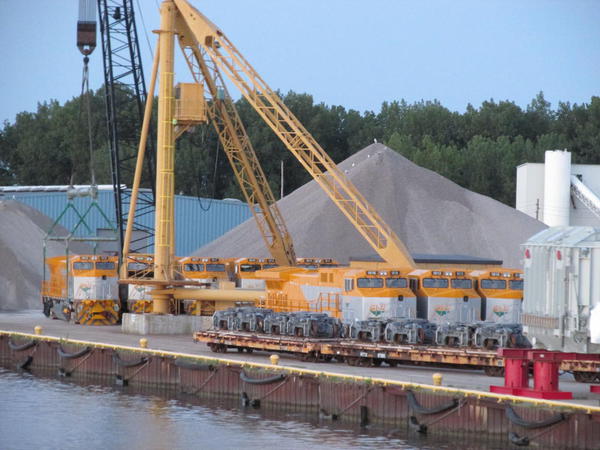Anybody else had an urge like this after seeing the real thing?
Anybody else had an urge like this after seeing the real thing?
Replies sorted oldest to newest
Having been born and raised about 90 mi. s. of Duluth, I've been to that area numerous times. Duluth is a very nice city, with hills looking down on Lake Superior. It's a beautiful drive up to Two Harbors along the rocky north shore of Superior. Two Harbors is home to the Edna G., as noted above, an operational tug that is the last steam powered vessel on the Great Lakes, and also several steam locomotives on display, including the No. 229, one of the few surviving examples of the huge DMIR Yellowstone steam engines.
I have a couple Lionel Duluth, Mesabi and Iron Range engines and a number of DMIR ore cars. Lionel and MTH have made DMIR engines, and and Lionel, K-line and MTH have made DMIR ore cars; MTH made several 6-car sets. I think there are a fair number of folks who run ore trains. Gets you in the mood when you see the real thing!
Two Harbors


#229 on Display in Two Harbors

Mallet locomotive #229, also known as a Yellowstone, was one of the largest locomotives made. Built in 1943, it went directly to helping transport materials during the war. When peace came, the Mallet was diverted to cross-country ore hauling between the Iron Range, Two Harbors and Duluth/Proctor. The Mallet is considered an example of a slow-drag freight articulated locomotive because, although slow, the Mallet was powerful and able to haul mile-long trains of iron ore. The Mallet located in Two Harbors is one of only three Yellowstones to be preserved.
DM&IR Yellowstone Mallet # 229, which is displayed opposite the venerable Duluth & Iron Range Railroad 3 Spot, was one of eighteen locomotives of this type. They came in two separate contracts of eight locomotives in 1941 and an additional ten locomotives in 1943. All were built by the Baldwin Locomotive Works at their Eddystone plant in Pennsylvania.
World War II was raging and America’s iron ore resource was absolutely vital to the war effort for building ships, tanks, and other military equipment. As one might expect, steel for military hardware took precedence over all nonmilitary use of steel. These Mallets however were so important when it came to moving the iron ore that they were assigned the A-1-A preference rating for the materials needed for construction. In other words the Yellowstones were a higher priority than military steel for tanks and ships. It is little wonder that they are often referred to as “the locomotives that defeated Hitler.”
Yellowstone # 229 was the second locomotive in the second group of Mallets (228-237) that were built in 1943. The 229 was completed and test run on January 5, 1943 and afterward scheduled to depart the Baldwin plant on January 9th. This was mid-winter and the ore season was closed in Minnesota. Rather than going to Duluth or Two Harbors, # 229 was sent to Denver, Colorado to be leased to the Denver Rio Grande & Western Railroad until the opening of the next ore shipping season. During that winter 229 pulled long freight trains over the Rocky Mountains and Continental Divide. Other Yellowstone sisters assisted on the Great Northern and Northern Pacific as well as the Denver & Rio Grande Western each year. When the 229 returned from Colorado in 1943, it was sent directly to Two Harbors to begin working on the Iron Range Division.
Nothing better than a pocket dock, lake freighter and an ore train. DMIR, Milwaukee or LS&I its all good! ![]()
The famous DM&IR Yellowstones, the locomotive with the most tractive effort of all the steamers. Beautiful engine
Two Harbors is home to the Edna G., as noted above, an operational tug that is the last steam powered vessel on the Great Lakes,
I have to correct that, there are still several steam powered ships on the Great Lakes, the Cason Calloway being one, plus it's two sisters - the Arthur Anderson and the Phillip R. Clarke. These are oil fired steam turbine bulk carriers, and there are a few more still out there as well. There also is one coal fired reciprocating ship - the cross lake car ferry S/S Badger which is in daily service during the summer and fall across Lake Michigan - and it is big, around 400' in length. It was built by the C&O Rwy and has cabins very reminiscent of sleeper cars in the late 40's. I'm a 1st mate currently sailing on the Lakes (at this very moment) and have worked on all three freighters mentioned above.
Your post was a very good description of the North Shore of Superior, and of the DMIR. There are also active ore docks in Marquette, MI (LS&I) and in Escanaba, MI (ex C&NW, now CN). As Charlie says, the pocket docks are the most interesting to watch in action. Also, a very good railroad musuem can be found in Duluth, with another Yellowstone...plus much more - and train rides to Two Harbors.
Oh yeah, I have about 80 ore cars and 4 Trainmasters to pull them.
Two Harbors is home to the Edna G., as noted above, an operational tug that is the last steam powered vessel on the Great Lakes,
I have to correct that, there are still several steam powered ships on the Great Lakes, the Cason Calloway being one, plus it's two sisters - the Arthur Anderson and the Phillip R. Clarke. These are oil fired steam turbine bulk carriers, and there are a few more still out there as well. There also is one coal fired reciprocating ship - the cross lake car ferry S/S Badger which is in daily service during the summer and fall across Lake Michigan - and it is big, around 400' in length.
There are also active ore docks in Marquette, MI (LS&I) and in Escanaba, MI (ex C&NW, now CN). As Charlie says, the pocket docks are the most interesting to watch in action. Also, a very good railroad musuem can be found in Duluth, with another Yellowstone...plus much more - and train rides to Two Harbors.
Yes, my statement was wrong. Meant to say the Edna G is the last steam-powered tug on the Great Lakes. I've ridden on the SS Badger - formerly operated by the C&O railroad. The 410-foot ship hauled RR cars across Lake Michigan, but I think now just takes cars (and of course passengers) across.
There has been a big issue with the ship now for several years, because EPA restrictions against dumping coal ash (which are full of really bad toxins) into the lake were going to require re-engining of the ship, and it was going to be put out of service unless modifications were made. The ship dumped huge tonnages of coal ash into Lake Michigan every year. It's operating this season under a temporary allowance, with a more efficient coal burning system, but next year will have to have modifications made to get off the coal.
Interesting that you work on the Lakes, John. I followed the Great Lakes ice story this winter with great interest (over 93% of the Lakes frozen over). Quite a challenge for the Coast Guard ice breakers - stretched to the limit. There were actually some icebergs floating in Superior this spring!
Those remaining operational ore docks are very interesting. Growing up I was familiar with the ones in Ashland, WI (there originally were three). The Canadian National inherited the last remaining Soo Line dock there and finally got permission to tear it down. That demolition is about complete now. Sorry to see it go. (The Ashland high school teams have the nickname "the Oredockers"!)

Boats go on ships!!!!! i.e. life BOATS. Anyway, I also thought that a backdrop of an Edmund Fitzgerald type ship would be great in scale and work your harbor, loading facilities, tracks etc. in front of the backdrop. I believe that they are at least 800' long so you would need at least 24' to do the backdrop justice unless you concentrated on just the holds for loading.
Boats go on ships!!!!! i.e. life BOATS.
I sure wouldn't try to explain THAT theory to someone in the U.S. Navy, especially one who served on a Submarine, or a PT Boat!
Then there are those "Lake Boats" that carry iron ore, "Tug Boats", "River Boats", off shore oil rig "Supply Boats", and the list goes on, and on.
I am ex-Navy. The Navy men and women out there know what I meant. It is the civvies that always call ships boats. Yes, I do know that subs are boats and there were PT and River boats. I was just trying to emphasize the fact that there is a big difference between ships and boats.
You can put a boat on a ship, but you can't put a ship on a boat.
But getting back on the main topic...... YES every time I see a real life train operation such as a coal depot, automobile factory loading cars, or if I ever did see an ore train.... I do get a sudden urge to model it in O Gauge.
It's kinda like when I saw hot metal cars and slag cars on sites and I had NO interest in them. I always thought "who would want that.... I've NEVER seen one for real". But then I saw a documentary on TV about making steel and all of the sudden I want some to model a steel mill!
I am also afflicted with the "when I see it in real life, I want it in O gauge" syndrome. This is the reason that I have started to buy modern diesels and freight cars although my layout and primary interest is set in the 1950s. Modern auto carriers and intermodal cars really don't look right behind a steam engine or early diesel.
I have seen some very good models of ore boats and docks in HO gauge. OGR published an article about an ore dock model several years ago. A photo of the dock was on the front cover. I don't recall if the dock came with an ore boat. Maybe someone can find the issue.
As an retired Navy man, I am always interested in ships and docks. These are a couple of photos of a ship model that I took at the 2011 NMRA National Convention in Sacramento, CA. I believe that the model was HO scale. The display was huge.
Attachments
You can put a boat on a ship, but you can't put a ship on a boat.
Does this mean that the USS Cole is a boat?
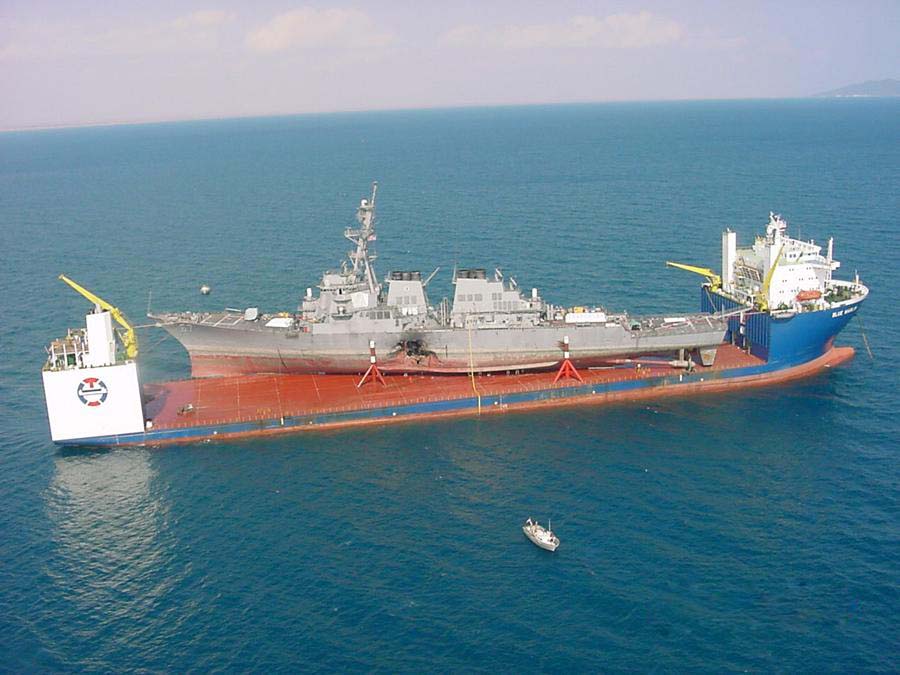
Stuart
Mike
Off the coast of Virgina Beach on the Mv Megan T Miller.
I am ex-Navy. The Navy men and women out there know what I meant. It is the civvies that always call ships boats. Yes, I do know that subs are boats and there were PT and River boats. I was just trying to emphasize the fact that there is a big difference between ships and boats.
Submarines are boats, and it will always be so, even though they are titled United States Ship. When the first subs were built, i.e. Turtle, Hunley and Holland, they were small enough to be classified as boats. Tradition dies hard in the Navy.
The same applies to Patrol/Torpedo Boats (PT), when they were conceived, they were quite small. River boats still are very small.
And, no Stuart, Cole is not a boat. ![]()
![]()
As a merchant sailor, I've always been fascinated by movement of cargo through the ports I travel too. I would love, in the future, to be able to model some sort of dock/pier for rail interchange. This creates quite the conflict between my prototype of choice (40's-50's), and wanting to model a modern port facility!
I am also afflicted with the "when I see it in real life, I want it in O gauge" syndrome. .....
I have seen some very good models of ore boats and docks in HO gauge. OGR published an article about an ore dock model several years ago. A photo of the dock was on the front cover. I don't recall if the dock came with an ore boat. Maybe someone can find the issue.
..... These are a couple of photos of a ship model that I took at the 2011 NMRA National Convention in Sacramento, CA. I believe that the model was HO scale. The display was huge.
Nice port model, with what appears to be a liberty ship. Although there are some large models of Great Lakes ore boats made, no port facility with ships is at all practical in O gauge. A relatively short 650' boat, for example, would have to be about 13 feet long.
Two Harbors is home to the Edna G., as noted above, an operational tug that is the last steam powered vessel on the Great Lakes,
I have to correct that, there are still several steam powered ships on the Great Lakes, the Cason Calloway being one, plus it's two sisters - the Arthur Anderson and the Phillip R. Clarke. These are oil fired steam turbine bulk carriers, and there are a few more still out there as well. There also is one coal fired reciprocating ship - the cross lake car ferry S/S Badger which is in daily service during the summer and fall across Lake Michigan - and it is big, around 400' in length. It was built by the C&O Rwy and has cabins very reminiscent of sleeper cars in the late 40's. I'm a 1st mate currently sailing on the Lakes (at this very moment) and have worked on all three freighters mentioned above.
Your post was a very good description of the North Shore of Superior, and of the DMIR. There are also active ore docks in Marquette, MI (LS&I) and in Escanaba, MI (ex C&NW, now CN). As Charlie says, the pocket docks are the most interesting to watch in action. Also, a very good railroad musuem can be found in Duluth, with another Yellowstone...plus much more - and train rides to Two Harbors.
Oh yeah, I have about 80 ore cars and 4 Trainmasters to pull them.
Having been born and raised about 90 mi. s. of Duluth, I've been to that area numerous times. Duluth is a very nice city, with hills looking down on Lake Superior. It's a beautiful drive up to Two Harbors along the rocky north shore of Superior. Two Harbors is home to the Edna G., as noted above, an operational tug that is the last steam powered vessel on the Great Lakes, and also several steam locomotives on display, including the No. 229, one of the few surviving examples of the huge DMIR Yellowstone steam engines.
I have a couple Lionel Duluth, Mesabi and Iron Range engines and a number of DMIR ore cars. Lionel and MTH have made DMIR engines, and and Lionel, K-line and MTH have made DMIR ore cars; MTH made several 6-car sets. I think there are a fair number of folks who run ore trains. Gets you in the mood when you see the real thing!
Two Harbors


#229 on Display in Two Harbors

Mallet locomotive #229, also known as a Yellowstone, was one of the largest locomotives made. Built in 1943, it went directly to helping transport materials during the war. When peace came, the Mallet was diverted to cross-country ore hauling between the Iron Range, Two Harbors and Duluth/Proctor. The Mallet is considered an example of a slow-drag freight articulated locomotive because, although slow, the Mallet was powerful and able to haul mile-long trains of iron ore. The Mallet located in Two Harbors is one of only three Yellowstones to be preserved.
DM&IR Yellowstone Mallet # 229, which is displayed opposite the venerable Duluth & Iron Range Railroad 3 Spot, was one of eighteen locomotives of this type. They came in two separate contracts of eight locomotives in 1941 and an additional ten locomotives in 1943. All were built by the Baldwin Locomotive Works at their Eddystone plant in Pennsylvania.
World War II was raging and America’s iron ore resource was absolutely vital to the war effort for building ships, tanks, and other military equipment. As one might expect, steel for military hardware took precedence over all nonmilitary use of steel. These Mallets however were so important when it came to moving the iron ore that they were assigned the A-1-A preference rating for the materials needed for construction. In other words the Yellowstones were a higher priority than military steel for tanks and ships. It is little wonder that they are often referred to as “the locomotives that defeated Hitler.”
Yellowstone # 229 was the second locomotive in the second group of Mallets (228-237) that were built in 1943. The 229 was completed and test run on January 5, 1943 and afterward scheduled to depart the Baldwin plant on January 9th. This was mid-winter and the ore season was closed in Minnesota. Rather than going to Duluth or Two Harbors, # 229 was sent to Denver, Colorado to be leased to the Denver Rio Grande & Western Railroad until the opening of the next ore shipping season. During that winter 229 pulled long freight trains over the Rocky Mountains and Continental Divide. Other Yellowstone sisters assisted on the Great Northern and Northern Pacific as well as the Denver & Rio Grande Western each year. When the 229 returned from Colorado in 1943, it was sent directly to Two Harbors to begin working on the Iron Range Division.
I found several photos that I took at the 2009 NMRA Convention in Hartford, CT. I believe that this is an N scale model. I should keep better notes when I take photographs. Joe
Attachments
I've seen an O gauge model of a pocket ore dock at a train show in Green Bay. It was pretty darn big, but still well short of the scale length of a pocket dock.
Re the SS Badger, I still take it several times a year across the Lake. The amount of ash flushed out was really blown up by the Chicago media and certain interests (an Illinois senator who had campaign donations from a competing fast ferry) but the agreement has been worked out, the Badger has a new computerized firing system and will implement a ash containment system soon. Still fired by coal.
Mike
Off the coast of Virgina Beach on the Mv Megan T Miller.
Being unfamiliar with the term, "saltie," I looked it up. A saltie is an ocean going vessel that does part of its trade in the Great Lakes. I guess that makes it like a salmon in some respects, returning from the ocean, and swimming upstream. I wonder, does it then spawn? Being a west coast sailor for my 22 year Naval Career, I had never come across that term before. I learned something today.
Salties spawn zebra mussels.
The Salties are ocean freighters from other countries, mostly, that enter the Great Lakes via the Saint Lawrence Seaway to do commerce in the US and Canada, dropping and picking up cargo. They then head back east on the St. Lawrence Seaway, heading to the North Atlantic, and on to their destinations overseas. Great Lakes "boats," though really ships, don't leave the Great Lakes and enter the Atlantic, for the most part, but confine their commerce to the areas of Canada and the US which border the Great Lakes. (Of course, the products carried by the boats are shipped all over from there).
Among other things, there have been serious problems with non-native species being carried into the Great Lakes environment by Salties. One of the worst has been the zebra mussel, which has created enormous problems, spreading even down here to Texas as it enters river systems from the Great Lakes. This mussel was carried into the Great Lakes in the bilges of some Salties, and discharged into the Lakes.
Here are a couple of photos from one of the layouts available to tour at the Chicago March Meet. I can't remember the owner's name. Unfortunately the layout list isn't posted on the Meet website so I can't come up with it. I do remember that it was one of the layouts on the near west side of downtown, maybe in Forest Park or a similarly named neighborhood.
The model is about 8' long as I recall. I think the owner may have purchased it from a vendor at the March Meet. All I know is that in the couple of years between visits, this boat appeared at the foot of the basement stairs. There was a series of photos displayed that chronicled what looked like a laborious process of getting the model into the basement. With Toledo being my hometown, I spent many many days with my Dad along the Maumee at the Anderson's grain elevator or out on the East side at the coal and ore docks. I enjoy where I live now, but I miss the industrial history and nature of Toledo and many parts of the midwest.
I would love to have more pictures but my camera battery died right after this. BOOOO!
Jim
Attachments
I saw this Wednesday while departing Erie, PA.
Notice the trucks on the flat cars, they appear to be meter gauge. My guess is that they are headed to some South American mining road. Nice to see that the US still exports something!
The saltie BBC Kibo is picking them up soon for their sea voyage.
Attachments
I've long dreamed of adding waterfront action to a future layout. At one point, modeling the PRR's Sodus Point, NY, coal pier seemed like the way I wanted to go. Then after reading various Sunrise Books on Railroading on the Waterfront in New York, car float operations became the new idea.
Finally, I came across and dove into the history of the Lake Michigan car ferries operated by the GT, C&O, etc. Since I also model RC ships, I thought what a great marriage! I fell for the SS City Of Milwaukee, originally built in 1931 for the GT. Luckily she is the last and only car ferry preserved in original configuration (rails on her car deck), and is located in Manistee, MI. I had the opportunity to visit her in mid-July:


A view of the car deck of the SS Badger (seen earlier in this thread). The rails are still there, but filled in with concrete as Badger only does vehicular traffic from Ludington, MI over to Manitiwoc, WI.

Here's inside of SS City Of Milwaukee with boxcars still on the rails:

Here are notional layout shots with a car ferry patterned after the SS City Of Milwaukee:

3D:


prr4935- As I mentioned in another post, when I was about 7 yrs old, I lived in Manitowoc, WI where the SS Badger would take trips to Ludington, MI and back. It was fun to watch the trains and cars being loaded onto the ferry. If you have the room to do it, that would be a great layout! Is it 12 X 16?
This is what I am interested in modeling. Lots of great action in the Port of Philadelphia.
Attachments
prr4935- As I mentioned in another post, when I was about 7 yrs old, I lived in Manitowoc, WI where the SS Badger would take trips to Ludington, MI and back. It was fun to watch the trains and cars being loaded onto the ferry. If you have the room to do it, that would be a great layout! Is it 12 X 16?
It's more like a 12x12. I have a restricted space in the basement of my 94-yr old home. And the size of the car ferry model in the RR Track design is not really representative of the true scale size of the car ferries. SS CofM is about 354 feet long so in 1/48 scale the model would be 88 inches long, about another foot longer than what you see in the screen shots.
I just like the old classic steamer lines of the SS CofM, the twin funnels, etc. You can sleep overnight onboard. That's what I did and got up early and snapped > 50 photos of details for when I start building the model.





